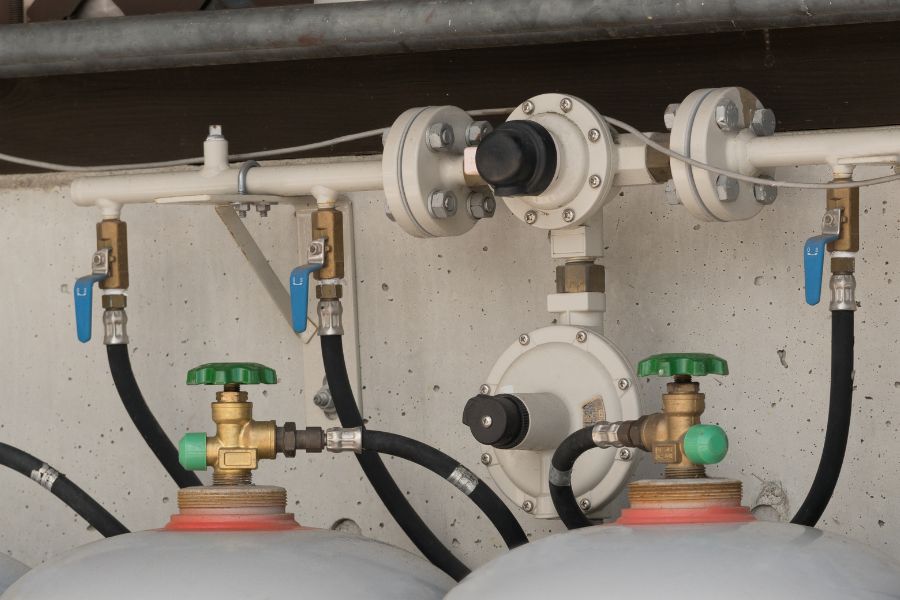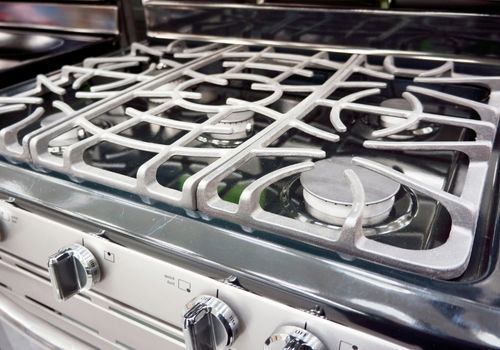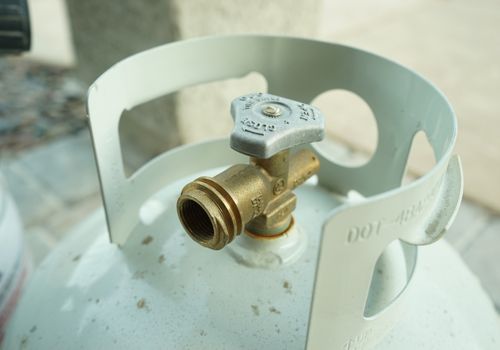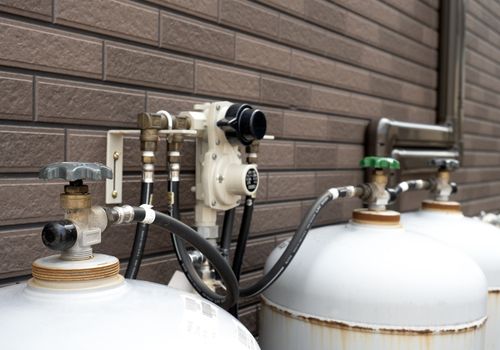The most reliable sign that your propane regulator is faulty is the presence of weak flames. Sometimes, your automatic RV propane regulator can be defective due to a manufacturing defect but these are uncommon.
My RV propane regulator works like a dream but that’s only because I learned how to fix some of the simple hitches I experienced over the years.
Propane regulators have a shelf life of approximately five years but most should work for longer if you learn how to fix some of the issues that arise when you’re using them.
In this article, I will explain the signs that indicate your propane regulator needs re-tuning as well as what you can do to fix problems when you notice them. Let’s get started:

Weak flames indicate a reduction in the amount of pressure that the propane is dispatched with. Propane could be flowing at a reduced pressure which means there may be a leak in the gas lines, a loose connection at the regulator, or simply a damaged regulator.
Examine the hose to ensure that no damage to the gas line is responsible for the reduced gas pressure. If the hose is intact, the problem could be the connector.
Apply soapy water to the connector using a small brush and wait to see if the connection point forms bubbles.
If so, the connector is not secure and propane is leaking, thereby reducing the pressure of the gas before it hits the burners.
If you don’t observe bubbles, your propane regulator is the problem. It means there is uneven back pressure impacting the bypass valve preventing enough propane from exiting the tank. You need to ‘burp the regulator’.
Turn off the tank and disconnect the hose from the propane tank. Turn on your gas grill and set the controls to high for about two minutes. This will extract all the propane vapors that are still in the hose and the regulator emptying the line.
Shut off the burner controls and reconnect the hose to the propane tank. Make sure you secure the hose to the connector tightly.
Turn on the propane tank letting the propane flow. Light the gas grill as you normally would. You should experience normal flames and adequate temperatures.
If your gas grill won’t ignite, yet you’re certain that there is propane in the tank, you could be looking at a leak or a broken regulator. A leak that can cause the ignition to fail completely would be rather severe, which means you can’t miss it.
If not, then the regulator may have automatically engaged the safety valve cutting off the propane flow to your burners and other appliances. This will happen if there is a high gas flow. To resolve this, you need to reset the gas regulator.
Turn off the propane tank or tanks and shut off all your appliances. This should reset the regulator within a minute or two. Ignite your stove and proceed with your cooking.
If this doesn’t work, however, there is nothing you can do. Your gas regulator needs to be replaced. I recommend the Camco Propane Double Stage regulator.
Soot deposits on the burners could be the result of grease building up on your burners over time. So, when left unattended, the layer just continues to develop as food particles and more grease attach to the burners.
Try cleaning out the crust and soot from your burners before interfering with the gas regulator. If a deep clean doesn’t do the trick, then your propane regulator could be producing flames that facilitate the formation of soot on both the burners and your cookware.
Often, these flames will be yellow or orange. A perfect flame is blue and produces no soot whatsoever. Yellow flames indicate inefficient combustion of fuel, in this case, propane.
This kind of combustion produces flames with a lower temperature than the desired blue flames along with impure carbon deposits which is what soot is composed of.

To fix this, you will need to adjust your venturi tubes to allow more air to flow through the air shutters and mix with propane for an optimally balanced complete ignition of your fuel.
This would fix the problem but if it reoccurs, and the air shutters can’t be adjusted further, then your propane regulator may be allowing too much propane to flow into the gas line. This means too much propane is ignited without first mixing with air in the right ratio.
The propane tank valve may have reached the end of its life and unfortunately, you will have no recourse here. Your propane regulator must be replaced.
The most common complaint I have heard is a whistling sound. This is certainly a gas leak and a significant one, so you should immediately turn off your appliances. The best move would be to contact a technician to find the leak and replace the offending component.
A small leak that only requires you to tighten the connector or the hose would not make any audible sound.
Popping sounds are a different issue altogether. If the popping sound is only coming from one burner, then it may be damaged and needs replacing.
If all the burners are producing this sound, however, the propane regulator is the problem. The sound should disappear once you replace the gas regulator.
Leaping, unstable or sputtering flames are all signs of malfunctions. The burners are likely damaged and could be releasing fuel inconsistently, creating this unusual behavior in the flames. If the flames are only occurring on one of your burners, the gas burner is faulty.
If the flames are happening on all your burners, your propane gas regulator may not be properly controlling the pressure of the gas supply as it flows out into the gas line. It will create an inconsistent flow that manifests as an unstable sputtering flame.
‘Burp’ the propane regulator to try and stabilize the flow pressure. If you fire up your burners and the flames continue to sputter, the bypass valve that regulates the flow pressure of the propane gas may be worn out or damaged.
Replace the bad propane regulator to prevent an imminent accident.
Gas leaks can occur at multiple locations along the propane system from the regulator all the way to the burners. Propane is an odorless gas but to ensure a gas leak is detectable, propane providers odorize propane by mixing it with mercaptan.
The additive is a harmless gas that gives propane a distinctive odor that is difficult to miss.
A gas leak in the connection hose should be fixed by a professional given the complexity of the double lp gas system found on an RV propane connection. That said, you can run a soap test at the regulator to find out if the leak is at the connector.
Apply a small amount of soapy water on the connector and wait to see if bubbles begin to form at that point. If they do, then the leak may be at the connector which means you may only need to secure the connector better to stem the leak.
If you can still detect that characteristic smell, your propane tank regulator is clearly broken or damaged. Replace it immediately.

This applies to dual propane tanks with automatic changeover regulators which are often found on RVs.
If the changeover doesn’t occur automatically and you are forced to make the change manually, the regulator could be glitching. Eventually, more hitches will begin to show up as it deteriorates further including the weak flames and gas leaks.
This is a sign of a faulty propane regulator.
This problem usually arises when propane regulators have clocked roughly ten years or longer. Automated changeover is a precise system and natural deterioration will easily cause it to malfunction indicating that the gas grill regulator needs to be retired. Replace it.
Frozen propane regulators are a rare occurrence and often happen in humid areas. Propane is a gas but in the tank, it is a liquid under high pressure. In warm areas, propane vapors can evaporate too fast and lodge in the regulator.
Without movement or flow, they condense causing the regulator to freeze up such that you cannot turn on the tanks. An LP gas regulator is built to avoid this but as I said, on rare occasions, it happens.
This problem usually corrects itself given time but you can encourage this by ensuring that your propane tanks are sitting on an even surface. This ensures the vapors are not flowing unevenly in the regulator and settling in the crevices encouraging condensation.
Additionally, if your propane tanks have just been refilled, they may be full to the brim which gives the vapors no room to form. Liquid propane flows very quickly into the regulator but in this state, it can’t flow out into the line. When this happens, the propane regulator fails.
Release some of the gas in an open area. A short release is sufficient and once you have replaced the propane tanks, let them sit for an hour and test the regulator again. If the regulator remains frozen, it may be permanently damaged and you will need a new one.
I mentioned checking for gas leaks by applying soapy water to the connection points and observing whether bubbles form. This confirms that there is a leak in the gas supply. You can also conduct the following RV propane regulator troubleshooting options.
Turn off the regulator and disconnect it from the propane gas tank. Disconnect the hose from the gas grill as well.
Light a candle and place it away from any wind flow to create a stable flame.
Ensure the regulator knob is in the OFF position and place it against the candle. Blow air through the hose and into the regulator. If you affect the flame or blow it off, the regulator is faulty. If the flame is not affected in any way, your regulator is fine.
Turn the regulator knob to the ON position and blow air into the regulator through the hose and towards the candle. If you only affect the flame slightly, you may have a clogged propane regulator. If you can blow out the flame then the regulator is working.
This test is effective but it cannot detect low gas pressure accurately. For that, you will need a pressure gauge.

Turn off the gas grill.
Attach the gauge to the test tap of your gas grill shut-off valve and set the burner controls to the highest setting. Compare the pressure of the flowing gas to the indicated pressure requirement on the tag.
A discrepancy in these figures indicates a malfunctioning regulator.
This test reads the static gas pressure which should not exceed the flowing gas pressure you have measured above by more than 30%.
Turn off all your propane appliances. Close every gas appliance’s shutoff valve. Turn on the propane tank and let the gas flow into the gas delivery system.
Leave the container service valve open. With the appliance shut-off valves turned off, the pressure in the gas lines will rise and then stabilize.
Observe the pressure readings for a minute. The reading should not fluctuate. If it moves up or down the regulator is bad and should be replaced.
Do not attempt a regulator lock-up test or a flow-pressure test without training or the help of a professional. When propane gas regulators are faulty, these tests expose you to the hazard of an explosion.